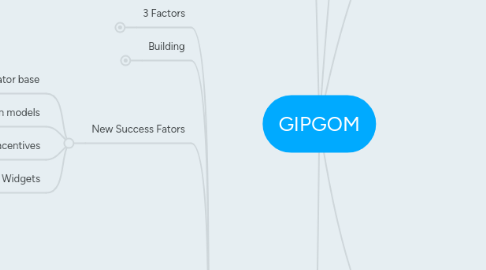
1. Growth
1.1. 3 Factors
1.1.1. Points
1.1.1.1. Flow // How well the platform fosters the exchange and co-creation of value
1.1.1.2. Gravity // How well the platform attracts participants, both consumers and producers
1.1.1.3. Connection // how easily other can plug into the platform to share and transact
1.1.2. 3 Building Blocks
1.1.2.1. The Magnet // The pull that attracts participants (incentives, reputation systems, pricing models, leverage of social media)
1.1.2.2. The Toolbox // Opensource development, allowing others to plug into the system. Content uploading, and ability to contribute + share.
1.1.2.3. The Matchmaker // Foster the flow of value by making connections between producers and consumer. Filtering noise over content.
1.2. Building
1.2.1. Content-First
1.2.1.1. Content > Connect
1.2.1.2. Easy content creation
1.2.1.3. Launch as single-user products
1.2.2. Network-First
1.2.2.1. Minimize signup friction
1.2.2.2. Connect > Content
1.2.2.3. Launch as multi-user products
1.3. New Success Fators
1.3.1. Growing the creator base
1.3.2. Strong curation models
1.3.3. Incentives
1.3.4. Creation of Widgets
1.4. User vs Customer
1.4.1. User
1.4.1.1. Types
1.4.1.1.1. Consumer
1.4.1.1.2. Produces
1.4.1.2. Contribution systems
1.4.1.2.1. What are the means of contribution?
1.4.1.2.2. How is this creative process easier than existing options?
1.4.1.2.3. What is the curation model to separate content from the noise?
1.4.1.2.4. Is there a democratic, equal opportunity way to the "top?"
1.4.1.2.5. Are there incentives beyond self-expression?
1.4.1.2.6. What is the strategy to convert consumers to creators?
1.4.2. Customer // Someone who pays
1.4.2.1. Producer
1.4.2.1.1. Paying for premium features or subsities
1.4.2.2. Consumer
1.4.2.2.1. Paying for product
1.4.2.3. 3rd Party
1.4.2.3.1. Advertisement
1.5. Removing Barriers
1.5.1. The Skill barrier
1.5.2. The Time/Effort Barrier
1.5.3. The Money Barrier
1.5.4. The Resource Barrier
1.5.5. The Access Barrier
1.5.6. Others?
1.5.6.1. I am (x) who wants to do (y) but can't because of (barrier)
1.6. Questions to consider
1.6.1. Can we co-create value? Connect with other businesses? Existing markets?
1.6.2. Do we have "early adopters" and "mainstream"
2. Market
2.1. System
2.1.1. The Problem
2.1.1.1. 엏떤 일을 해야되는데, 시간 이 업다, 기술이 업다, 아니면 (또는) 의지가 업다.
2.1.2. Pipe
2.1.2.1. 광고
2.1.2.1.1. TV
2.1.2.1.2. 신문
2.1.2.1.3. 전단지
2.1.2.1.4. 광고판
2.1.2.1.5. 소문
2.1.2.1.6. 인터냇
2.1.2.2. 방문
2.1.2.2.1. 우연히...
2.1.2.2.2. 동내사람들....
2.1.3. Optimization
2.1.3.1. Portal (Naver/Daum)
2.1.3.1.1. Internet access
2.1.3.2. 114
2.1.3.2.1. No internet access
2.1.3.3. Broker
2.1.3.3.1. Digital (O2O)
2.1.3.3.2. Anologue
2.1.3.3.3. Emplyment
2.1.4. Platform
2.1.4.1. Kakao?
2.1.4.2. Freemoa
3. Phase Outline
3.1. PHASE 3
3.1.1. Economic of Communion
3.1.1.1. Value added to society
3.2. PHASE 2
3.2.1. WHAT
3.2.1.1. Educational opportunities to learn new skills and trade
3.2.1.2. Employment opportunities for companies
3.2.2. WHO
3.2.2.1. Individuals
3.2.2.1.1. Professional
3.2.2.1.2. Unprofessional
3.2.2.2. Academies
3.2.2.2.1. Academies which teach new manual labor skills can offer courses.
3.2.2.3. Companies
3.2.2.3.1. Companies who want to hire
3.2.2.3.2. Companies who want to go on MT's
3.3. PHASE 1
3.3.1. WHAT (Objectives)
3.3.1.1. Provide a trustworthy, quick, and cost effective platform to connect clients with skilled laborers.
3.3.1.1.1. Rating system
3.3.1.1.2. Award system
3.3.1.2. Empower the community to better control the home improvement market by directly connecting the work with the workers.
3.3.1.2.1. Create bidding system to create higher competition, no middle man.
3.3.1.2.2. Social networking and rating system allows the community to help each other create a trustworthy and quality platform.
3.3.1.3. To activate marginalized skilled workers: disabilities, age, racial minority, etc.
3.3.1.3.1. Equal work opportunity regardless of condition of the worker.
3.3.1.3.2. Social network and rating system puts focus back on work quality and cost.
3.3.1.4. Create a social community where the focus is on human relationships, as much as it is on the "economics"
3.3.1.5. Educate the general public with manual skills (Setting up for phase 2 transition)
3.3.2. WHO (Target)
3.3.2.1. Skilled Workers
3.3.2.1.1. Professional
3.3.2.1.2. Unprofessional
3.3.2.1.3. Marginalized
3.3.2.2. Property Owner
3.3.2.2.1. Owners who have "home improvement" projects (may range from very simple to very complex) who have...
3.3.3. HOW
3.3.3.1. Mobile (Primary)
3.3.3.2. Website (Secondary)
3.3.3.2.1. Site Map
3.3.3.2.2. Requirements
3.3.3.2.3. 3 Plates
3.3.3.2.4. Potential Domains
3.3.3.3. Fairs & Conventions
3.3.4. Risks
3.3.4.1. Market Research
3.3.4.2. Gathering mass
4. Platform Scenario & Casestudy
4.1. Precedents
4.1.1. Airtasker
4.1.1.1. Careers
4.1.1.1.1. Product Designer
4.1.1.1.2. Digital Designer
4.1.1.1.3. Customer Experience Specialist
4.1.1.1.4. Product Owner
4.1.2. Airbnb
4.1.2.1. Careers
4.1.2.1.1. Engineering
4.1.2.1.2. Data Science & Analytics
4.1.2.1.3. Finance & Accounting
4.1.2.1.4. Business Development
4.1.2.1.5. Customer Experience
4.1.2.1.6. Design
4.1.2.1.7. Employee Experience
4.1.2.1.8. Information Technology
4.1.2.1.9. Legal
4.1.2.1.10. Operations
4.1.2.1.11. Localization
4.1.2.1.12. Marketing & Communications
4.1.2.1.13. Photography
4.1.2.1.14. Product
4.1.2.1.15. Public Policy
4.1.2.1.16. Research
4.1.2.1.17. Talent
4.1.2.1.18. Trust and Safety
4.1.3. Youtube
4.1.3.1. Careers
4.1.3.1.1. Engineering
4.1.3.1.2. Product & Design
4.1.3.1.3. Business & Operations
4.1.4. Instagram
4.1.4.1. Careers
4.1.4.1.1. Software Engineering
4.1.4.1.2. Data & Analytics / Sales & Marketng
4.1.4.1.3. Design & UE/UI
4.1.4.1.4. Interns & Co-Ops
4.1.4.1.5. Business Development & Partnerships
4.1.4.1.6. Sales & Marketing
4.1.4.1.7. Product Management
4.1.4.1.8. Sales & Business Development, Business development & Partnerships
4.1.4.1.9. Communications & Public Policy
4.1.5. Facebook
4.1.5.1. Careers
4.1.5.1.1. Advertising Technology
4.1.5.1.2. Communications & Public Policy
4.1.5.1.3. Information Technology
4.1.5.1.4. Legal, Finance, Facilities & Admin
4.1.5.1.5. People & Recruiting
4.1.5.1.6. Security
4.1.5.1.7. WhatsApp
4.1.5.1.8. Building 8
4.1.5.1.9. Data & Analytics
4.1.5.1.10. Infrastructure
4.1.5.1.11. Oculus
4.1.5.1.12. Product Management
4.1.5.1.13. Software Engineering
4.1.5.1.14. Business Development & Partnerships
4.1.5.1.15. Design & User Experience
4.1.5.1.16. Instagram
4.1.5.1.17. Online Operations
4.1.5.1.18. Sales & Marketing
4.1.5.1.19. Technical Program Management
4.2. Users
4.2.1. Working married couple
4.2.1.1. Consumer
4.2.1.2. Producer
4.2.2. Elderly retired couple
4.2.2.1. Consumer
4.2.2.2. Producer
4.2.3. Single adult
4.2.3.1. Single Mom
4.2.3.2. Single Dad
4.2.3.3. Widow
4.2.3.4. Unmarried
4.2.4. Migrant Workers
4.2.5. Professionals
4.2.6. Students

